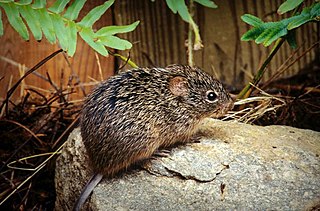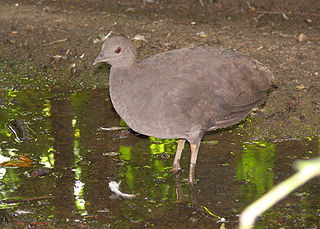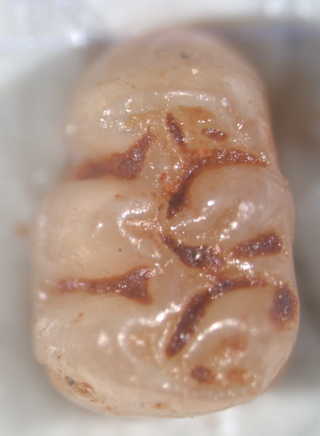
Phascolarctos is a genus of marsupials with one extant species, the koala Phascolarctos cinereus, an iconic animal of Australia. Several extinct species of the genus are known from fossil material, these were also large tree dwellers that browsed on Eucalyptus leaves.

The rodent subfamily Sigmodontinae includes New World rats and mice, with at least 376 species. Many authorities include the Neotominae and Tylomyinae as part of a larger definition of Sigmodontinae. When those genera are included, the species count numbers at least 508. Their distribution includes much of the New World, but the genera are predominantly South American, such as brucies. They invaded South America from Central America as part of the Great American Interchange near the end of the Miocene, about 5 million years ago. Sigmodontines proceeded to diversify explosively in the formerly isolated continent. They inhabit many of the same ecological niches that the Murinae occupy in the Old World.

The hoary bat is a species of bat in the vesper bat family, Vespertilionidae. It lives throughout most of North America.

Pagaibamba Protection Forest is a protected natural area in the region of Cajamarca, Peru. The area was declared a protection forest in order to preserve the water supply of surrounding towns, preserve the water cycle of the area, protect road infrastructure and protection of soils by preventing erosion.

Crypturellus is a genus of tinamous containing mostly forest species. However, there are the odd few that are grassland or steppe tinamous. The genus contains 21 species.

The cinereous tinamou, also known as brushland tinamou, is a type of ground bird found in swamp and lowland forests in northern South America. They have some localized names that have been used by the indigenous people such as in Amazonas where they are called inambu-pixuna, and in Pará, Brazil where they are called nambu-sujo. Also, throughout their range they are called inhambu-preto. Cinereous tinamous have been around for many centuries. They are part of the oldest families of the world today and have fossils discovered dating back tens of millions of years. Their quick reflexes play a role in their ability to survive.
The Colombian forest mouse is a species of rodent in the family Cricetidae. Some authorities consider it to be the only species in the genus Chilomys, while others accept Chilomys fumeus as being a valid species, and it may form part of a species complex. It is found in Colombia, Ecuador, and Venezuela.
Nephelomys auriventer, also known as the golden-bellied oryzomys or Ecuadorian rice rat, is a species of rodent in the genus Nephelomys of family Cricetidae. Oldfield Thomas originally described it, in 1899, as a species of Oryzomys, Oryzomys auriventer, and considered it most similar to Oryzomys aureus. In 1926, a subspecies was described from an Ecuadorian locality, Oryzomys auriventer nimbosus, and it was suggested that O. auriventer was closely related to O. albigularis. This proposal was formalized in 1961 by including O. auriventer within the species O. albigularis, but by 1976 O. auriventer was recognized again as a separate species. In 2006, Oryzomys albigularis and related species, including O. auriventer, were transferred to the new genus Nephelomys. Simultaneously, the former subspecies nimbosus was recognized as a separate species, Nephelomys nimbosus.
The golden Oldfield mouse or golden thomasomys is a species of rodent in the family Cricetidae. It is found in Colombia, Ecuador, Peru, and Venezuela. Both the common and genus name commemorate the British zoologist Oldfield Thomas who worked at the Natural History Museum, London and studied South American rodents.

Thomasomys is a genus of rodent in the family Cricetidae, named after British zoologist Oldfield Thomas. Nuclear DNA sequence analysis has indicated that it is a sister taxon to Rhagomys. It contains the following species:
The ash-colored Oldfield mouse is a species of rodent in the genus Thomasomys. It is found in montane forests of the Department of Cajamarca in northern Peru, at elevations of 1,524 to 3,818 metres. Until 2023, it was thought to be more widely distributed, ranging into southern Ecuador, but these populations are now identified as three separate, closely related species, T. lojapiuranus, T. pagaibambensis, and T. shallqukucha.
The Apeco Oldfield mouse is a species of rodent in the family Cricetidae. It is known only from a single locality in north central Peru, which includes Rio Abiseo National Park, where it was found in cloud forest at an elevation of 3300 m. The species name comes from the acronym for the Asociacion Peruana para la Conservacion de la Naturaleza. It is among the largest members of the genus.

Thomasomys ucucha, also known as the ucucha thomasomys, is a rodent in the genus Thomasomys of the family Cricetidae. It is known only from high altitude forest and grassland habitats in the Cordillera Oriental of Ecuador. Seven other species of Thomasomys live in the same areas. First collected in 1903, T. ucucha was formally described as a new species in 2003 and most closely resembles T. hylophilus, which occurs further to the north. The species is listed as "vulnerable" in the IUCN Red List as a result of habitat destruction.

Agathaeromys is an extinct genus of oryzomyine rodents from the Pleistocene of Bonaire, Netherlands Antilles. Two species are known, which differ in size and some details of tooth morphology. The larger A. donovani, the type species, is known from hundreds of teeth that are probably 900,000 to 540,000 years old, found in four localities. A. praeuniversitatis, the smaller species, is known from 35 teeth found in a single fossil site, which is probably 540,000 to 230,000 years old.
Antonio Brack's Oldfield mouse is a species of sigmodontine rodent in the family Cricetidae known from Peru. The species is named after Peruvian ecologist Antonio Brack Egg.
Thomasomys lojapiuranus is a species of rodent in the genus Thomasomys known from Peru and Ecuador. It consists of populations that were identified as Thomasomys cinereus until they were identified as a new species in 2023.
Thomasomys shallqukucha is a species of rodent in the genus Thomasomys known from the Andes of northern Peru. It consists of populations that were identified as Thomasomys cinereus until they were identified as a new species in 2023.








